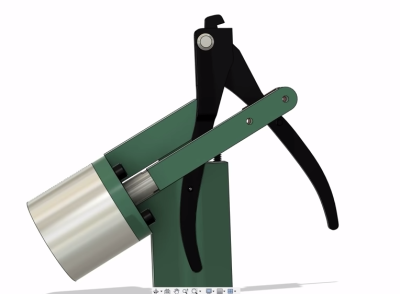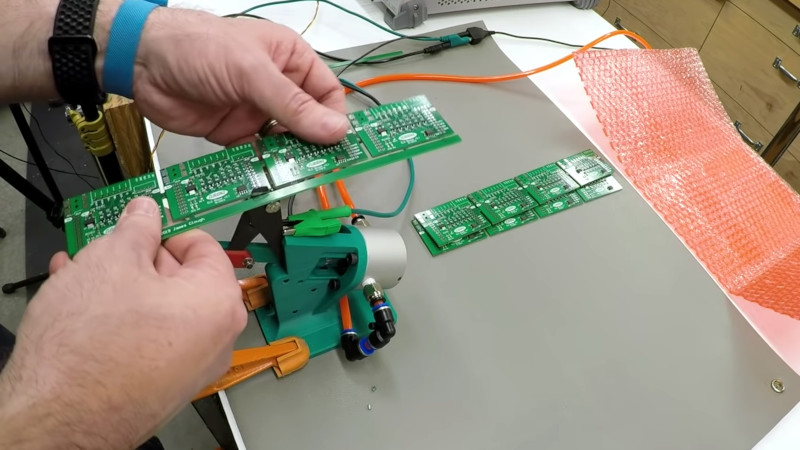In high volume production, smaller PCBs are often “panelized” so that multiple copies can be shuffled through assembly as a single piece. Each board is attached to the panel with a few strategically placed tabs, not unlike the sprues in a plastic model kit. If you only have to separate a few boards you can simply cut them with a hand nipper, but when you’re doing hundreds or thousands of boards, it quickly becomes impractical.
 Which is where [Clough42] found himself recently. Looking to improve the situation without breaking the bank, he decided to automate his trusty hand-held depanelizer tool. The basic idea was to build an actuator that could stand in for his own hand when operating the tool. He already had a pneumatic cylinder that he could power the device with, he just needed to design it.
Which is where [Clough42] found himself recently. Looking to improve the situation without breaking the bank, he decided to automate his trusty hand-held depanelizer tool. The basic idea was to build an actuator that could stand in for his own hand when operating the tool. He already had a pneumatic cylinder that he could power the device with, he just needed to design it.
In the video below, he walks the viewer though his CAD design process for this project. His first step, which is one that’s often overlooked by new players, is creating digital representations of the hardware he’s using. This allows him to quickly design 3D printed parts that have the proper dimensions and clearances to interface with his real-world components. Remember: it’s a lot easier to adapt your 3D model to the components on hand than the other way around.
With the appropriate valves, hoses, and a foot pedal attached to the pneumatic cylinder, he’s able to operate the cutter completely hands-free. He still has to manually move the panel around, but at least it saves him from the repetitive squeezing motion.
With a tool like this and a custom testing jig, you’ll be producing PCBs like the pros in no time.
[Thanks to Anathae for the tip.]
















early steps in the evolution of the bandsaw..
Mouse bites? V-groove score and break?
yes i was thinking that – don’t use mouse bites use vscores then just snap them off by hand, you don’t need this thing
You can only v-score straight lines across the whole panel: useless on rounded shape for nice looking enclosures.
And if you break by hand instead of using the pizza slicer tool, you are running the risk of breaking MLCC close to the edges. (which is a bad design anyway).
Depanelizer described in this post can also cut only straight lines. That is not a problem. Rounded corners can be CNC routed in a way, they seamlesly transition into V-scored line. So the breaking only happens in the straight segments, while the rounded ones are already pre-cut.
Yes, you can transition from straight v-scorred to rounded corner but you need some lost material between 2 boards (for the router bit diameter), otherwise the transition is not smooth. Then why not have it fully routed with mouse-bites?
Some fabs won’t process V cuts or will charge extra.
Correct. The fab I used will not assemble v-score boards.
That’s a pity, as vscorred are way faster to depanelize even without the specific pizza slicing tool.
As your board looks plain rectangular, I would have asked for it (or changed EMS) as designing such tool must have taken days to design. (and still need to be operated).
What no frikin’ lasers?
Lasers tend to have trouble with the glass fibers in the board substrate. Thinking…
I didn’t have one in my junk bin.
Hundreds of boards?
Maybe
Thousands?
No way.
Just post some flyers in the public places of the local college.
Provide Pizza and cheap gloves.
More than two toppings and you over-paid.
Pneumatic depaneling tools have already existed for a while.